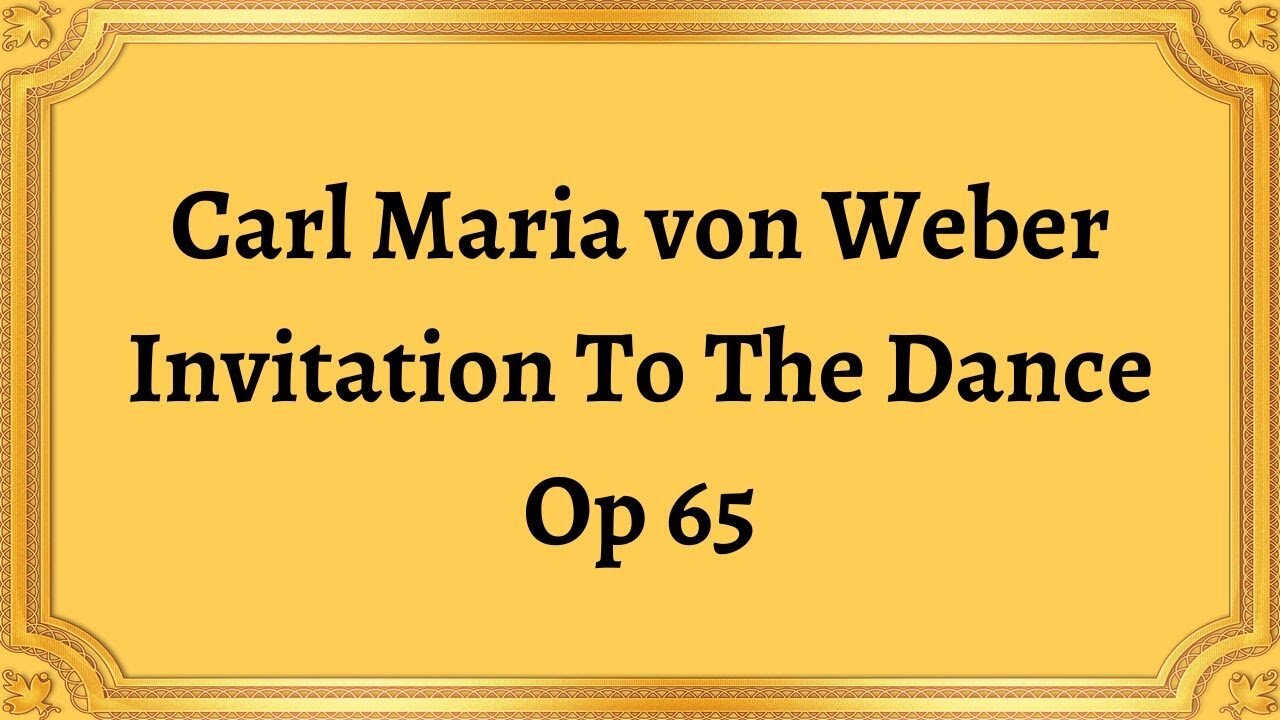Premium Only Content

Carl Maria von Weber Invitation To The Dance Op 65
#CarlMariaVonWeber #InvitationToTheDance #Opus65 #ClassicalMusic
#ComposerSpotlight #Ballet #Orchestra #Dance #RomanticEra
#GermanComposer #MusicAppreciation
Publication date 1951
Orchestra Of The Royal Opera House, Covent Garden; Hugo Rignold
Carl Maria von Weber's Invitation to the Dance Op. 65 is a remarkable musical composition that seamlessly integrates the elegance of dance with the rich tapestry of Romantic-era music. Originally written for solo piano, this enchanting piece has captivated audiences since its creation in 1819.
Carl Maria von Weber was a prominent German composer and conductor during the early 19th century. Invitation to the Dance was composed during the Romantic era, a period characterized by a fascination with emotions, nature, and individual expression. Weber's composition captured the essence of this era, showcasing his ability to infuse music with narrative and evoke a range of emotions.
Invitation to the Dance follows a narrative structure that takes the listener on a journey through various dance movements. The composition begins with a graceful introduction, setting the stage for the unfolding story. It then transitions into a waltz, depicting the elegance and charm of a dance hall. The piece progresses through contrasting sections, exploring different dance styles and moods, before culminating in a vibrant and triumphant finale.
Weber's Invitation to the Dance is characterized by its masterful orchestration and lyrical melodies. The composition showcases Weber's ability to create intricate harmonies, expressive phrasing, and dynamic contrasts. The piece incorporates elements of classical music, such as sonata form, while infusing it with a sense of romanticism through its melodic richness and emotional depth.
Weber's Invitation to the Dance draws inspiration from the world of dance, capturing the spirit and energy of various dance forms. The waltz, in particular, serves as the centerpiece of the composition, reflecting the popularity of this dance during the Romantic era. Weber's ability to translate the physicality and grace of dance into musical form is a testament to his skill as a composer.
Invitation to the Dance has left an enduring legacy in the world of classical music. Its captivating melodies, evocative storytelling, and seamless integration of dance elements have made it a staple in both orchestral and piano repertoire. The piece has been arranged and adapted for various instruments and has been performed in concert halls and dance theaters worldwide.
Carl Maria von Weber's Invitation to the Dance Op. 65 is a remarkable example of the fusion of music and dance. Its historical significance, captivating structure, and masterful musical elements have secured its place in the canon of classical music. Whether experienced through a piano performance or as part of an orchestral arrangement, Invitation to the Dance continues to enchant audiences with its elegance, narrative quality, and the enduring beauty of its melodies.
You have the opportunity to support the channel https://destream.net/live/RadSiarAl/donate
-
 LIVE
LIVE
Wendy Bell Radio
5 hours agoNothing To See Here
12,191 watching -
 2:12:18
2:12:18
TheDozenPodcast
21 hours agoIslam vs Christianity: Bob of Speakers' Corner
45.6K13 -
 14:36
14:36
The StoneZONE with Roger Stone
1 day agoRoger Stone Delivers Riveting Speech at Turning Point’s AMFEST 2024 | FULL SPEECH
48K19 -
 18:59
18:59
Fit'n Fire
11 hours ago $4.23 earnedZenith ZF5 The Best MP5 Clone available
18K1 -
 58:34
58:34
Rethinking the Dollar
20 hours agoTrump Faces 'Big Mess' Ahead | RTD News Update
20.5K5 -
 5:35
5:35
Dermatologist Dr. Dustin Portela
20 hours ago $1.44 earnedUnboxing Neutrogena PR Box: Skincare Products and Surprises!
15.9K2 -
 11:20
11:20
China Uncensored
19 hours agoCan the US Exploit a Rift Between China and Russia?
42.3K15 -
 2:08:48
2:08:48
TheSaltyCracker
14 hours agoLefty Grifters Go MAGA ReeEEeE Stream 12-22-24
237K673 -
 1:15:40
1:15:40
Man in America
17 hours agoThe DISTURBING Truth: How Seed Oils, the Vatican, and Procter & Gamble Are Connected w/ Dan Lyons
139K129 -
 6:46:07
6:46:07
Rance's Gaming Corner
19 hours agoTime for some RUMBLE FPS!! Get in here.. w/Fragniac
170K4